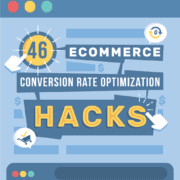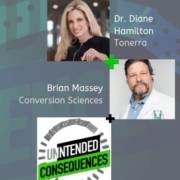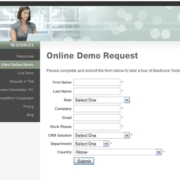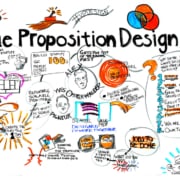How To Persuade Landing Page Visitors To Convert
They came.
They saw.
They left immediately and never returned…
You’ve worked very hard to get visitors to your landing page. You’ve probably spent a lot of money as well. And while you are ready to sell to them now, you might be getting ahead of yourself.
If you want customers to push your buttons, you have to push theirs first.
A lot of ecommerce websites function more or less like this: “Hey, here’s my company… aren’t we neat? Look at these things you can buy.” And that’s why their conversion rate is less than 2%.
If you want to really convert landing page visitors, there are a few things you need to do.
1. Understand Your Visitor’s Journey
Your visitor came from somewhere. That may seem obvious, but it’s important to acknowledge. When they land on your page you don’t want them to have to re-orient them self or re-set their expectations of what happens next.
Your landing page should pay off the promise made on the page that directed your visitor to it, and it should give them a way to take action. Anything else is friction and window dressing. Your goal should be to remove as much of it as you can, while delivering on your promise and providing a good experience for your visitor.
Obviously you are going to want some content in there so your visitor knows they’re in the right place and what they need to do, but beyond that…all that friction is stuff you’re putting in place to serve your needs, not your visitors’, and it will likely hurt you.
But I get that you need to generate leads – that’s not serving the customer, though. So it’s important that you accept up-front that not everything on your landing page is there to help the customer. Knowing how to minimize that self-serving part of the page is how you’ll maximize conversions.
Make sure your landing page has the elements your visitor expects, and that it provides a seamless experiential flow from the referring page. Your landing page URLs have to be unique to each referring source, and the content of the page, while accomplishing your goals, must be designed with the referring page’s content in mind.
That referring page has set up an expectation in your visitor’s mind. Of what they’ll get when they land on your page, what they’ll have to do and what they might have to provide. We call this expectation priming, and it can be overt or subliminal.
2. Prime Your Visitors’ Subconscious
Priming is the use of one kind of stimulus to influence the response to another stimulus. What does that mean? Well, if you read a website about “better sleep” and “tossing and turning” and “frustrating” and “sleeplessness” and “sleep disorder” you can probably guess that the site is about “insignia” even if the site never uses the word.
And how did you know that word should have been “insomnia” and not “insignia”? Because your brain was primed by the sleep-related words to tell you that the word that makes the most sense is different from the word you read, and your brain is constantly trying to make sense of the information it processes, and it will compensate without you thinking about it.
These groups of words that we associate with a specific thing make up its schema, which is just shorthand for the way our brains organize thoughts, behaviors, ideas and the relationships among and between those pieces of information. We’re going to come back to this idea of schemas a few times in this course.
In the meantime, words have the power to make us feel things deep in our subconscious, so reading that insomnia site before bed might make you…unable to fall asleep.
Everything we see, taste, touch, smell and hear is information being passed to the brain through our nervous system. How we interpret those things comes from limbic system of the brain which controls emotions, memories, learning and the regulation of responses to triggers.
In marketing, if we can prime our audience with schemas that trigger specific parts of the brain, we can nudge the subconscious to respond in specific ways. Create anxiety about being able to fall asleep, maybe you can induce insomnia.
Stimulus 1: words about insomnia
Response to Stimulus 1: not feeling sleepy
Stimulus 2: time for bed
Response to Stimulus 2 (under influence of response 1): not feeling sleepy
Priming is also important in your customer journey, mentally preparing your customer for the next step toward their decision. For landing pages the priming process begins before the visitor lands on your page. As a marketer you have to be aware of where the visitor has come from, and which channel led them to your site.
Did they see a link in an email? Did they see a button in an email? Did this visitor click a link on a general website, or was it specifically about something, perhaps a partner’s or influencer’s website? Did they click a display ad? Did they click a paid search result? Did it come from social media?
Each of these routes speaks to the customer having different experiences and expectations up to the moment they landed on your site.
You probably can’t meet every expectation with a single landing page, so you must be prepared to make custom landing pages for each channel – and you should count each influencer and partner website and as its own channel.
3. Create Open Loops
Better known as cliffhangers in the cock-a-doody chapter plays, and those few seconds before the clock pops up on the screen at the end of an episode of 24.

Open loops are an anxiety-inducing Hollywood device that make you just have to tune in the next week. Even before Dr. Phil told us about it, human brains and emotions were programmed to need closure. We want to know how things work out. Leave an open loop and…well, we just can’t resist it. We just have to know. It’s an itch we can’t help but want to scratch.
Your CTA isn’t an open loop. It’s the thing that closes a loop. It’s not an itch you have to scratch. An open loop makes your brain scream “What happens next?” and drives you crazy until you find out.
Some loops get closed quickly, like walking to the vending machine with some change. That loop gets closed when you have a Snickers in your hand. Pretty boring (even if it really satisfies), right?
But what if you increase the stakes? What if you need that candy because a co-worker is hypoglycemic and is in danger of going into diabetic shock in the office unless they get a Snickers? No change. Not really. You might be a little anxious for a minute but that loop still closes pretty quickly when you get the candy bar.
So what if you increased the stakes again? What if the candy machine was out of order? Now we have an open loop and some actual consequences of it staying open. Now it’s compelling.
I know what you’re thinking, you can’t put all that jeopardy on your CTA. And that’s true, which is why you have to acknowledge the first truth: your CTA doesn’t exist in a vacuum. It exists alongside other content on the page, and that’s where you open the loop (you might even open it on the referring page).
Clicking the button is the same as putting the money in the vending machine, and the Snickers is the email they get that confirms their download or subscription has been successful. Loop closed, disaster averted.
So what should your supporting copy say? Well, let’s not get ahead of ourselves? We need to understand how our audience processes the page they’ve landed on.
4. Utilize Visual & Language Processing
Neuroscientists at MIT measured the brain’s ability to process words and images. They found that people were able to accurately, if broadly, describe images that were flashed in front of them for as little as 13 milliseconds.
Now, an example for the sporty among you: a 100 m.p.h fastball can go from the pitcher’s mound to home plate in 412 milliseconds. To get the ball from the mound to the plate in 13 milliseconds, the pitcher would have to pitch at 3,173 m.p.h. – about twice as fast as a bullet or a single frame of a movie being played at 2.5x speed.
For words, though, it’s a different story. We can speak about 120-160 words per minute and remain clear; and listening, we can process between 300 and 500 words per minute, which is why those disclaimers on radio ads work, even though the guy sounds like the chipmunk who failed the audition.
Our brains compensate. Those three words are a central theme to this post.
Amazingly, our brains get used to how words look when they’re written. We expect the word “word” to be a uniform height for about 80% of its shape, and then pop up at the very end. Like this:

It’s this visual word shape (it’s called the Bouma shape, after Dutch researcher Herman Bouma) that helps us process common words as pictures, and then fill in the details. It’s the uncommon or unfamiliar words that kick the language centers of our brains into action to sound out what exactly we’re reading.
Word recognition speeds hover around the 150 millisecond range, with actual comprehension happening around 20 milliseconds later. Recognition of words in sans-serif fonts are an average of about 8 milliseconds faster. So remember next time you want to use Baskerville or Century Old Style or Garamond – they slow down how fast people read compared to Arial, Geneva and Open Sans. And depending on what you’re trying to achieve, that might not be a bad thing.
So remember when you look at a landing page, your brain is way ahead of you processing the images on the page before you can even recognize that there even are words on the page, let alone understand what they say.
Time to process image: 0.013 seconds.
Time to process words: 0.170 seconds.
The hero, header or background image is your first opportunity to prime a schema in your audience. Visuals should always be considered a fundamental part of what you’re trying to communicate and not an afterthought, or something nice to add a pop of color. They have the potential to persuade or confuse your audience. If you treat visuals like language, they will provide powerful support for your writing. The words and concepts we store in schemas are in what we’ll call “semantic neighborhoods,” so let’s talk about that.
5. Semantic Neighborhoods of Words
Let’s talk for a moment about the semantic neighborhoods of words. Here’s a list:
- Daisy
- Lily
- Rose
- Iris
What’s the next word? Is it Tulip or is it Elizabeth?


Well, that all depends on whether you’ve been primed with a schema for girls names or flowers. But those words all exist in the semantic neighborhoods of both “girls names” and “flowers.” And in conjunction with priming, semantic language neighborhoods are tremendously powerful.
Words tend to be related to other words. Not just as synonyms, but as a way for us to discern the meanings of sentences. If you’d been asked to identify not the next word, but what those four words have in common, it would be a lot easier to accurately identify that theme if the fourth word more clearly established what kind of linkage or similarities these words shared.
- Daisy
- Lily
- Rose
- Tulip
Is a list of flowers while:
- Daisy
- Lily
- Rose
- Elizabeth
Is a list of girls’ names
So some words are capable of helping us unlock the meaning of others. If primed correctly, some words are capable of unlocking the meaning of others to nudge our brain into doing something.
These groups of words are said to be in the same semantic neighborhood. So just as cats and dogs are in the semantic neighborhood of “pets,” if you were primed with language in the semantic neighborhood of “insomnia” it could make it difficult to fall asleep.
Imagine you are a creative for a coffee brand. You want to put your customer in the semantic neighborhood of “tired” and keep them there so they keep making coffee, using it up faster to make them buy more frequently. Maybe you send them an email about the bad things that can happen when a person gets tired. You put a picture of a hammock on your website. You use the word “bed” in your social media posts. You make sure your content partners are using native advertising for that piece about the top 5 cartoon dogs (including a picture of Droopy). Then get Upworthy to publish that article about the physiological reasons we yawn.



Seriously, I yawned writing that paragraph.
Using schemas and semantic language neighborhoods is like taking your SEO keyword strategy and using it to trigger emotions or memories in your audience instead of making your website rank higher.
6. Design Desire Paths
You’ve probably heard the term “path of least resistance,” and that’s more or less what desire paths are. When things get designed in a way that forces a user to create their own “unofficial” pathway to accomplish their goals, that’s a desire path and a design failure. This kind of friction is usually caused by designers (or the decision makers who have the final say) putting the company’s needs first, and thinking the visitor will use the site the way the designer wants them to, rather than how humans always do: with the least brain effort possible.

Don’t imagine that your landing page visitors are going to use the internet in a way you don’t, just because it’s how you’d like them to use it. For the most part they expect certain things on a landing page: brief copy, a CTA button, maybe some kind of a form to fill out – if they don’t see those things, they’re going to go looking. If your designer places them on the page in a way that makes your visitor have to think about it, they’ll abandon.
We’d all like to think our visitors are happy to provide their email address and shoe size in exchange for an ebook, but realistically…not so much. Assume that after two fields, every mandatory data capture field on your page is going to double your abandon rate.
In UX design, it’s generally accepted that users read in one of two ways:
F shape: from left to right from the top to the bottom, with decaying interest as they cross and descend the page. If this is how your landing page visitors are going to consume the page, you should probably place your most important information in the top left, and the least important in the bottom right.
Diagonally: from top left to bottom right. If this is how your audience will consume your page, then you should avoid putting anything important in the bottom left or top right. Or, put things you want to bury in those spaces.
But how do you know how your visitor will consume your page? You can influence that in a couple of ways. First, by laying out your copy or page elements that way. Second, by the use of images that draw the eye in specific directions.

Remember this picture? Imagine you’re placing a CTA button on the page. Would you place it in the top or bottom half, to the left or right?
Most of the “interesting” part of the picture is in the bottom half. Despite the fact that most of the “free space” is in the top half, the eye is drawn to the bottom because that’s where the subject of the image is.
Since the angle of the sleeper’s arms draws your attention to the bottom right, you might want to place your copy in the top left and your CTA in the lower right. Because that’s where the viewer’s eye is going to go. Putting the CTA in the bottom left would mean the viewer has to exert mental effort to even look at it. You don’t want that. People are lazy, and work makes them abandon pages. Put the important things right in the middle of those desire paths.
There are tools out there that can track mouse activity and even where focus group users’ eyes go. If you can use one to identify the hot zones on your landing page, that’s where you should put your most important elements.
7. Include Targeted Triggers
Making your audience feel anything through the use of words and pictures is hard. Making them feel something specific is even harder. There are seven classic copywriting triggers you should know about:
Fear – All the cool kids are doing it, why aren’t you?
Guilt – You can help; why aren’t you helping?
Value – You don’t want to miss this great deal!
Belonging – You’re one of us; our tribe is the best.
Leadership – Be the best or first to do or know something.
Gratification – Get it right now!
Trust – This works, with no hidden fees, ask our customers.
For some of these, telling people they don’t have what it takes makes defiance a strong trigger.
For example: You wouldn’t want this, you’re not really a leader…
…DEFIANT CLICK.
8. Write Outstanding Copy
Finally, time to talk about the words…
I don’t want to say that the words are the least important thing on your landing page but…they’re the last thing the brain is going to process. Good words will have a heck of a time making up for bad layout, UX design or image selection – first impressions really do count and it shouldn’t all be left to the copywriter to try to save a bad situation.
Humans are lazy. That’s why the brain has to compensate so much. If you make your visitors have to engage their brain to think, you’re asking them to do too much work. And that will result in abansoned visits.
Words are the thing that, once your visitor reads them, will be given the most thoughtful consideration. And that means they can potentially do as much harm as good, so whatever you choose to write, make sure it’s amazing. To keep your visitor’s brain out of the conversation, fewer words is better, but stay away from slogans and meaningless statements. Don Miller of StoryBrand recommends the “grunt test,” which is that if you showed your landing page to a caveman for five seconds, would they be able to tell you what it’s about?
If everything else is in order, by the time the brain reads the words, the job should be mostly-done. But the problem is…when you’re designing the page, you’re going to need to do something you might be unaccustomed to doing: start with the words. Why? Because in the hands of a talented copywriter, the use of psychology, emotional trigger words, descriptors, themes and evocative language are formidable tools that intrigue the brain. Done right, they’ll help your designer build a bridge to the glorious click that your visitor can’t help but cross – and they’ll probably think getting to the click was their idea.
Copywriting, especially conversion rate optimized (CRO) copywriting, is a specific skill. Most writers don’t have it.
Out of every 100 people who think they can write
- 80 don’t have a distinctive voice or perspective
- 20 have a strong voice
- 10 have a voice and opinion
- 5 of them can also crank out concise ideas at an industrial rate
- 1 has ideas that are good/original enough to support campaigns
Maybe. I might be over-estimating.
The point is: Good direct response copywriters are rare. Really rare. It’s not the same discipline as writing grants, white papers, long-form blogs or social media updates. Not all writers are created equal, so don’t think the blogger you’ve hired can write landing pages. They probably can’t.
Here are some things to remember as you write your copy.
- Serve your audience’s needs first otherwise they’ll abandon.
- Keep it short and simple. Reduce friction.
- Your visitor already cares enough to be on your page. Don’t disappoint them.
- Your images should have primed your reader, so you don’t have to tell them what they see.
- Avoid clichés and slogans. Make your copy meaningful.
- Focus on the benefits or results, not the features.
- Say it plainly. Be human. Don’t make them have to engage their brain.
- Make your CTA obvious and enticing with triggers.
- Make your benefit easy to remember and repeat so it gets shared.
- If you’re creating multiple landing pages, make your copy relevant to the narrow audience for that specific version of the page.
Conclusion
I hope you found this helpful. With these tools, you’ll be better equipped to turn incoming visitors into leads and customers.
Remember that the conversion process is intentional. It’s not passive. The more you understand your customer, the better you’ll be able to push their buttons.
- How To Persuade Landing Page Visitors To Convert - July 13, 2017














Nice tips, specially the priming part. I really loved the flower or girl example.
Thanks, Arun.